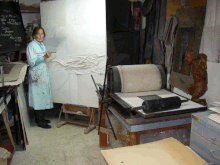Chava Pressburger
Chava Pressburger (* 21st February 1930 in Prague as Eva Ginzová ) is a Czech-Israeli painter and paper artist.
Life
Together with her older brother Petr Ginz , she grew up in a Jewish family that was interested in many different cultures . For example, the Esperanto-speaking community played an important role in the family. The parents received visitors from all over the world, so the children came into contact with different cultures and nationalities at an early age.
After the German defeat of Czechoslovakia in March 1939, all anti-Jewish prohibitions and regulations soon applied to the Ginz family, even though the mother was not Jewish.
According to the National Socialist definition, the parents' marriage was a " mixed marriage ", which protected the Jewish father from deportation until shortly before the end of the war . However, this protection did not apply to Eva and her brother, who belonged to the Jewish religious community and could be sent to a concentration camp as " valid Jews " from the age of 14 .
In 1942 Eva's brother Petr was deported to Theresienstadt and later to Auschwitz , where he was murdered in the gas chambers. Two years later, in 1944, Eva followed her brother to Theresienstadt. Here she experienced the liberation in May 1945 together with her father, who had also been interned there for the last three months. After the war, she returned to Prague with her father.
In the following years Pressburger attended grammar school and, at the same time, the art school for applied arts in Prague. Via Paris - where she studied at the École des Beaux-Arts - she and her future husband Jindrich Pressburger emigrated to Israel in 1949, where she still lives and works today. In Israel she changed her first name to the Hebrew spelling Chava.
plant
In art, Pressburger found the strength to deal with the past, worked on fragments and created his own forms. Inspired by the art movements of the post-war period in Prague and later also in Paris, Pressburger dealt intensively with abstract art . Important sources of inspiration in her art are the Shoah and the problematic political situation in Israel, but also the Kabbalah , a mystical tradition of Judaism.
In the beginning there were large-format oil paintings that became more and more abstract over the years. Pressburger later shifted her focus to the design of paper she had made herself.
Paper production plays a central role in the artist's oeuvre. For eight years she was in charge of the paper production department in the Visual Art Center (Be'er Scheva). During this time she dealt intensively with the history of the regionally different traditions of Japanese paper production and developed her own technique from this. In nature, she collects suitable plants or other unprocessed materials, cooks, washes and grinds them into individual fibers. At the end of this process, the moist - sometimes colored paper - is reassembled into a unit with the help of a hydraulic press.
Her paper sculptures are a new step in the artistic career. The viewer has to change his position again and again, and depending on how the light falls on the object, the effect changes. Sequences disappear in the dark, others emerge further in the light, whereby this impression is reinforced by the irregular surface of the paper. The paper that Pressburger needs for her sculptures is made from waste paper.
Honors
- 1992 Prize of the Sussmann Art Foundation, Vienna
- 2010 silver medal for the dissemination of Czech culture abroad from the Czech Senate
Movies
- 1978 Documentary about Chava Pressburger, Israeli Archives for Painting and Sculpture
- 2003 Documentary about Chava Pressburger, Czech TV (Vzpominky, které neshorely)
Exhibition catalogs
- Chava Pressburger: The Road Through Theresienstadt , exhibition catalog, Jerusalem 1984.
- Chava Pressburger: Impressions on paper , exhibition catalog, Jerusalem 1995.
- Chava Pressburger: Beit Levitus - The Story of a House , exhibition catalog, Prague 2000. ISBN 80-86159-27-2
- Chava Pressburger: In the Garden of Memory , o. O. 2004. ISBN 0-9745909-3-2
- Chava Pressburger: Silence and Solitude , exhibition catalog, o. O. 2012
literature
- Ilka Wonschik: Chava Pressburger - Pictures, Paper Works , Sculptures , Hentrich and Hentrich Verlag, Berlin 2016, ISBN 978-3-95565-166-4 .
- Ilka Wonschik: It was probably another star on which we lived ... - Artists in Theresienstadt , 2nd edition, Berlin 2014, ISBN 978-3-95565-026-1 .
- Hedwig Brenner : Jewish women in the fine arts - A biographical directory, Vol. II , Konstanz 2004, p. 272 ff. ISBN 3-89649-913-0
- Petr Ginz : Prager Tagebuch 1941–1942 , Prague 2004. ISBN 978-3-8270-5245-2
- Leopold-Hoesch-Museum Düren: I. International Biennal of Paper Art - Handmade Paper , exhibition catalog, Düren 1986. ISBN 3-925955-00-3 .
- Pavla Neuner: Interview with Chava Pressburger , in: Jewish Witness to a European Century , Vienna o. J.
- Vera Schwarcz: Bridge Across Broken Time. Chinese and Jewish Cultural Memory, New Haven, London 1998. ISBN 978-0-300-20978-5
- Alexandra Zapruder (Ed.): Salvaged Pages - Young Writers' Diaries of the Holocaust , New Haven a. London 2004. ISBN 978-0-300-10307-6
Web links
- Chava Pressburger in the Guardian
- Chava Pressburger in the Jewish Museum Prague Czech Republic
- Chava Bratislava Archives
- Chava Pressburger at centropa.org
Individual evidence
- ↑ a b c Ilka Wonschik: Chava Pressburger - Pictures, Paper Works , Sculptures , Hentrich and Hentrich Verlag, Berlin 2016, ISBN 978-3-95565-166-4 .
- ↑ webdecker - www.webdecker.de, webdecker - www.webdecker.de: Chava Pressburger - Hentrich & Hentrich Berlin - publisher of Jewish culture and contemporary history. In: www.hentrichhentrich.de. Retrieved September 24, 2016 .
| personal data | |
|---|---|
| SURNAME | Pressburger, Chava |
| ALTERNATIVE NAMES | Ginzová, Eva (maiden name); Ginz, Eva; Ginz, Evah; Presburger, Havah; Presburger, Hayah; פרעסבורגער, חוה; גינז, אוה |
| BRIEF DESCRIPTION | Czech-Israeli painter and paper artist |
| DATE OF BIRTH | February 21, 1930 |
| PLACE OF BIRTH | Prague |
